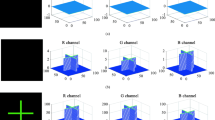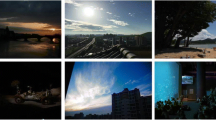Abstract
Under low illumination, the colour constancy of human vision can be used for correctly determining the colour of objects according to the fixed reflection coefficient of external light and objects. However, video image acquisition equipment does not implement the colour constancy characteristic of the human visual system. Under low illumination, only a small amount of light is reflected from the surface of the imaged object; as a result, the captured image is underexposed. After statistical analysis of low-light images, these inverted underexposed images appear foggy. Inversion is a uniform and reversible operation that is performed on the entire image. Hereby, a method is proposed for resolving low-light images using conventional physical models. First, a low-light image is inverted for obtaining a foggy image. Subsequently, a pyramid-type dense residual block network and a dark channel prior K-means classification method are applied to the foggy image, to calculate the transmission and atmospheric light. Finally, the parameters obtained from this solution are incorporated into the low-light imaging model to obtain a clear image. We subjectively and qualitatively analysed the experimental results, and used information entropy and average gradient for objective quantitative analysis. We demonstrate that the algorithm improves the overall brightness and contrast of the imaged scenes, and the obtained enhanced images are clear and natural.










Similar content being viewed by others
References
Anish M, Rajiv S, Alan C et al (2013) Making a ‘Completely Blind’ image quality analyzer. IEEE Signal Processing Letters 20(3):209–212
Arqub OA, Al-Smadi M (2020) Fuzzy conformable fractional differential equations: novel extended approach and new numerical solutions. Soft Computing, https://doi.org/10.1007/s00500-020-04687-0
Arqub OA, Al-Smadi M, Momani S et al (2016) Application of reproducing kernel algorithm for solving second-order, two-point fuzzy boundary value problems. Soft Computing 21(23):7191–7206
Arqub OA (2015) Adaptation of reproducing kernel algorithm for solving fuzzy Fredholm–Volterra integrodifferential equations. Neural Comput and Applic 28(7):1591–1610
Arqub OA, AL-Smadi M, Momani S et al (2015) Numerical solutions of fuzzy differential equations using reproducing kernel Hilbert space method. Soft Comput 20(8):3283–3302
Berman D, Tali T, Avidan S (2016) Non-local image dehazing. In: IEEE Conference on computer vision and pattern recognition, pp 1674–1682
Cai B, Xu X, Jia K et al (2016) Dehazenet: An end-to-end system for single image haze removal. IEEE TIP 25(11):5187–5198
Cai J, Gu S, Zhang L (2018) Learning a deep single image contrast enhancer from multi-exposure images. IEEE Trans Image Process 27(4):2049–2062
Celik T, Tjahjadi T (2011) Contextual and variational contrast enhancement. IEEE Trans Image Process 20(12):3431–3441
Chandrasekharan R, Sasikumar M (2018) Fuzzy Transform for contrast enhancement of non-uniform illumination images. IEEE Signal Process Lett 25(6):813–817
Chen C, Chen Q, Xu J et al (2018) Learning to see in the dark. In: IEEE Conference on computer vision and pattern recognition, pp 3291–3300
Conde MH, Zhang B, Kagawa K, Loffeld O (2016) Low-light image enhancement for multiaperture and multitap systems. IEEE Photonics Journal 8(2):1–25
Dabov K, Foi A, Katkovnik V, Egiazarian K (2007) Image denoising by sparse 3-d transform-domain collaborative filtering. IEEE Trans Image Process 6(8):2080–2095
Dong X, Wang G, Pang Y et al (2011) Fast efficient algorithm for enhancement of low lighting video. IEEE International Conference on Multimedia and Expo, pp 1–6
Fu X, Zeng D, Huang Y et al (2016) A weighted variational model for simultaneous reflectance and illumination estimation. In IEEE Conference on computer vision and pattern recognition, pp 2782–2790
Guo X, Li Y, Ling H (2017) LIME: Low-light image enhancement via illumination map estimation. IEEE Trans Image Process 26(2):982–993
He K, Sun J, Tang X (2011) Single image haze removal using dark channel prior. IEEE Trans Pattern Anal Mach Intell 33(12):2341–2353
Huynh-The T, Le BV, Lee S et al (2014) Using weighted dynamic range for histogram equalization to improve the image contrast. EURASIP J Image Vid Process 2014(1):44
Huang S, Cheng F, Chiu Y (2013) Efficient contrast enhancement using adaptive gamma correction with weighting distribution. IEEE Trans Image Process 22(3):1032–1041
Jobson DJ, Rahman Z, Woodell GA (1997) Properties and performance of a center/surround retinex. IEEE Trans Image Processing 6(3):451–62
Kim T, Paik J, Kang B (1998) Contrast enhancement system using spatially adaptive histogram equalization with temporal fifiltering. IEEE Trans Consum Electron 44(1):82–87
Land EH, McCann JJ (1971) Lightness and retinex theory. J Opt Soc Am 61(1):1–11
Land EH (1977) The retinex theory of color vision. Scientifific American 237(6):108–128
Lee C, Lee C, Kim C-S (2012) Contrast enhancement based on layered difference representation. In: Image Processing, pp 965–968
Li L, Wang R, Wang W et al (2015) A low-light image enhancement method for both denoising and contrast enlarging. In: IEEE International conference on image processing, pp 3730–3734
Li J, Klein R, Yao A (2017) A two-streamed network for estimating fine-scaled depth maps from single rgb images. In: The IEEE international conference on computer vision, pp 695–704
Li B, Peng X, Wang Z, Xu J, Feng D (2017) Aod-net: All-in-one dehazing network. In: IEEE International conference on computer vision, pp 4770–4778
Li L, Si Y, Jia Z (2018) Medical image enhancement based on CLAHE and unsharp masking in NSCT domain. J Med Imaging Health Informatics 8 (3):431–438
Li M, Liu J, Yang W et al (2018) Structure-revealing low-light image enhancement via robust retinex model. IEEE Trans Image Process 27 (6):2828–2841
Li JJ, Li GH, Fan H (2018) Image Dehazing using Residual-based Deep CNN. IEEE Access, 1–1
Loh YP, Chan CS (2018) Getting to know low-light images with the exclusively dark dataset. Comput Vis Image Understanding 178:30–42
Lore KG, Akintayo A, Sarkar S (2017) Llnet: A deep autoencoder approach to natural low-light image enhancement. Pattern Recogn 61:650–662
Lu H, Li Y, Uemur T et al (2018) Low illumination underwater light field images reconstruction using deep convolutional neural networks. Future Generation Computer Systems 82:142–148
Ma J, Fan X, Ni J et al (2017) Multi-scale retinex with color restoration image enhancement based on Gaussian filtering and guided filtering. Int J Modern Phys B 31(16):1744077
Ma K, Zeng K, Wang Z (2013) Perceptual quality assessment for multi-exposure image fusion. IEEE Trans Image Process 24(11):3345–3356
Meng G, Wang Y, Duan J et al (2013) Efficient image dehazing with boundary constraint and contextual regularization. Proceedings of international conference on computer vision, pp 617–624
Mittal A, Moorthy AK et al (2012) No-reference image quality assessment in the spatial domain. IEEE Trans Image Process 21(12):4695–4708
Narasimhan SG, Nayar SK (2000) Chromatic framework for vision in bad weather. In: IEEE Conference on computer vision and pattern recognition, vol 1, pp 598–605
NASA (2001) Retinex image processing. http://dragon.larc.nasa.gov/retinex/pao/news/
Narasimhan SG, Nayar SK (2003) Contrast restoration of weather degraded images. IEEE Trans Pattern Anal Mach Intell 25(6):713–724
Omer I, Werman M (2004) Color lines: Image specific color representation. In: IEEE Conference on Computer Vision and Pattern Recognition, vol 2, pp 11–13
Ren W, Liu S, Zhang H et al (2016) Single image dehazing via multi-scale convolutional neural networks. In: European conference on computer vision, vpp. 154–169
Shen L, Yue Z, Feng F et al (2017) Msr-net:low-light image enhancement using deep convolutional network, arXiv:1711.02488
Simonyan K, Zisserman A (2014) Very deep convolutional networks for large-scale image recognition. arXiv:1409.1556
Vonikakis V, Kouskouridas R, Gasteratos A (2018) On the evaluation of illumination compensation algorithms. Multimed Tools Appl 77(8):9211–9231
Wang T, Ji Z, Sun Q et al (2016) Label propagation and higher-order constraint-based segmentation of fluid-associated regions in retinal SD-OCT images. Info Sci 358:92–111
Wang Y, Chen Q, Zhang B (1999) Image enhancement based on equal area dualistic sub-image histogram equalization method. IEEE Trans Consum Electron 45(1):68–75
Wang S, Zheng J, Hu HM et al (2013) Naturalness preserved enhancement algorithm for non-uniform illumination images. IEEE Trans Image Process 22(9):3538–3548
Wei C, Wang W, Yang W et al (2018) Deep retinex decomposition for low-light enhancement. British Machine Vision Conference, arXiv:1808.04560
Xu Z, Yang X, Li X et al (2018) Strong baseline for single image dehazing with deep features and instance normalization. British Machine Vision Conference, pp 243
Ying Z, Li G, Ren Y et al (2017) A new image contrast enhancement algorithm using exposure fusion framework. International Conference on Computer Analysis of Images and Patterns, pp 36–46
Zhang H, Patel VM (2018) Densely connected pyramid dehazing network. In: Proceedings of the IEEE conference on computer vision and pattern recognition, pp 3194–3203
Zhao H, Shi J, Qi X et al (2016) Pyramid scene parsing network. arXiv:1612.01105
Zhang Y, Tian Y, Kong Y et al (2018) Residual dense network for image super-resolution. In: The IEEE Conference on computer vision and pattern recognition, pp 2472–2481
Zhang H, Dana K, Shi J et al (2018) Context encoding for semantic segmentation. In: The IEEE Conference on computer vision and pattern recognition, pp 7151–7160
Zhang H, Patel VM (2018) Density-aware single image deraining using a multi-stream dense network. In: The IEEE Conference on computer vision and pattern recognition, pp 695–704
Zhang W, Hou X (2018) Light source point cluster selection-based atmospheric light estimation. Multimed Tools Appl 77(3):2947–2958
Acknowledgment
The authors acknowledge the National Natural Science Foundation of China (Grant nos. 61772319, 61976125, 61873177 and 61773244), and Shandong Natural Science Foundation of China (Grant no. ZR2017MF049).
Author information
Authors and Affiliations
Corresponding author
Additional information
Publisher’s note
Springer Nature remains neutral with regard to jurisdictional claims in published maps and institutional affiliations.
Rights and permissions
About this article
Cite this article
Feng, X., Li, J. & Hua, Z. Low-light image enhancement algorithm based on an atmospheric physical model. Multimed Tools Appl 79, 32973–32997 (2020). https://doi.org/10.1007/s11042-020-09562-6
Received:
Revised:
Accepted:
Published:
Issue Date:
DOI: https://doi.org/10.1007/s11042-020-09562-6




